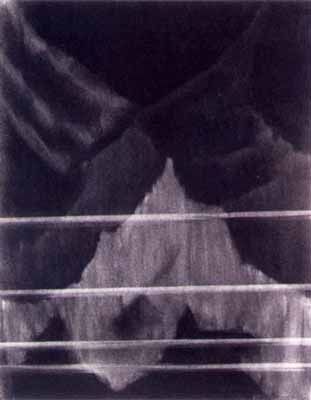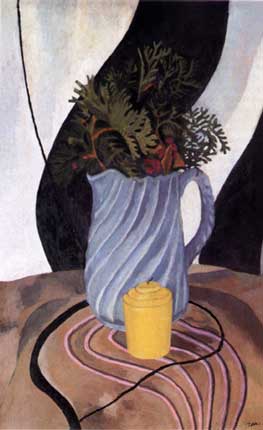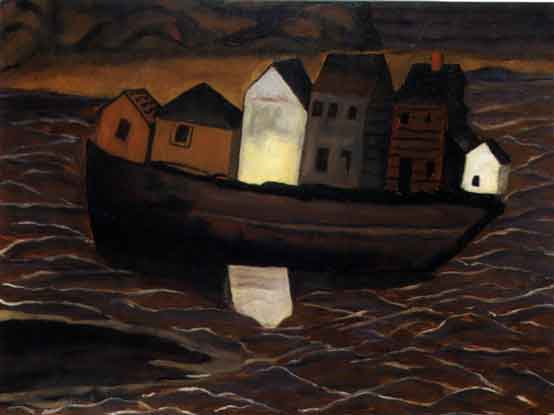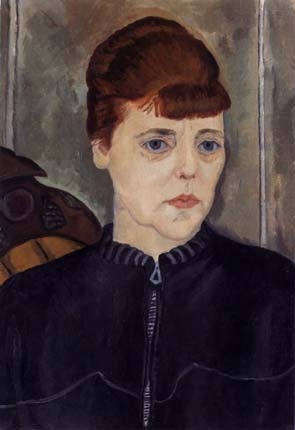
Hill Forms, n.d. Charcoal on paper,
14" x 10 7/8". Private Collection.
Out of the Shadows: A RetrospectiveHelen Torrby Donald Goddard |
 Hill Forms, n.d. Charcoal on paper, 14" x 10 7/8". Private Collection. |
The title is appropriate, not simply because Helen Torr's work deserves recognition, but as a description of the work itself. Torr studied to be an artist in Philadelphia, where she was born in 1886, but didn't consistently work at her art until she met the painter Arthur Dove in about 1919 (although they may also have met earlier). They left their spouses in 1921, lived together on a boat anchored near northern Manhattan and in Huntington Harbor, Long Island, then moved to Geneva, New York, and back to Centerport, Long Island, where Dove died in 1946. Torr and Dove were exceptionally devoted to one another, through much tribulation and lack of funds, and more than that they were aligned with one another. In their work, and presumably in their lives, they were totally interdependent, part of each other. As artists, one did not fully exist without the other. Together they were truly at the center of a world that radiated magnificently from the confines of their boat on the water, and later from a one-room house (now preserved as the Newsday Center for Dove/Torr Studies in Centerport, directed by Anne Cohen DePietro, chief curator of the Heckscher Museum of Art in Huntington). |
|
Dove, who was six years older than Torr, began
painting seriously in 1906, traveled to Europe in 1908 with his first wife, was
profoundly influenced by Cubism, and then became a crucial figure of modern American
painting in New York, where he had his first one-man show at Alfred Stieglitz's
Gallery 291 in 1912. But he then largely stopped painting, applied himself, as
an illustrator, to providing for his wife and child, and moved with them in 1917
to Westport, Connecticut, where he met Torr, who moved there in 1919 with her
illustrator husband. No paintings or drawings of Torr's remain from the pre-Dove
period, so it is uncertain what she actually did after attending classes at the
Pennsylvania Academy of the Fine Arts between 1906 and 1912, apparently as a
valued student. Once together, however, both Torr and Dove began painting again,
he until the end of his life, and showing almost every year, she until he became
gravely ill in 1939. Then she drew a little, beautifully, but stopped making
art altogether when he died. With Dove gone, she barely acknowledged that she
had been an artist.
|
 Still Life with Pitcher and Candle, 1932-33. Oil on board, 21 3/8" x 13 1/2". Private Collection. |
It is almost impossible to accurately date most of Torr's work and therefore difficult to apprehend her evolution as an artist. I suppose she was influenced by Marsden Hartley, Georgia O'Keeffe, and other contemporaries she knew and saw, but it doesn't really matter. Torr and Dove derived their individuality from their connection to each other and their surroundings, which means that in the strength of their bond their sensibilities are really quite different. Dove is intensely devoted to understanding and expressing the underlying dynamics of experienced phenomena, natural and otherwise--of light, sound, growth, movement, weather--and how they relate to one another as line, color, and form. It's a complex universe that exists everywhere. Torr is interested in the emergence of images--"out of the shadows." She assumes that there is a structure, based perhaps on Dove's passionate and constant explorations, or perhaps simply from looking through windows or at the configurations of a boat. |
| In fact, in the 1920s Torr did charcoal drawings of a ship's mast and interior. She also did paintings and drawings that are completely, or nearly completely, abstract, though usually an image appears, part of a larger structure but powerful and basic in its insistence as a form, as if it were being seen for the first time, as if the act of seeing was one of forming something that was not there before one saw it--not conceived it, but saw it. The charcoal drawing Hill Forms has a particularly spectral quality that describes a transformation from vague gradations of mist dimly seen through to actual landscape shapes beyond a horizontal railing, which may be that of a boat. Most mysteriously here, the entire effort is to confirm that something is there and that it is distinct within the pattern of which it is a part. In other works the image is perfectly clear: the cube shape of a lighthouse, the peaked square of a shed along the shore, a quince on a white glazed hand dish. These things are not metaphorical or archetypal, they are real, and so, perhaps because they are real, there is a magic to conjuring them up, to finding places for them in the medium of a painting or drawing. |
 Houses on a Barge, 1929. Oil on canvas, 16 1/4" x 21". Private Collection. |
| In Still Life with Pitcher and Candle, the blue pitcher, with its curved, parallel fluting, is the transitional form through which the curvilinear ridges of the tan tablecloth reach the larger black-and-white curvilinear pattern of the background. There is a kind of existential joke here, that the pitcher, and the candle in front of it, convey the language of the structure from which they emerge in terms that are comprehensible to us, that they are even useful, and that they contain and convey the energy that is apparent in every aspect of the world around them. One is compelled to think about the fact that the shape is a pitcher, a specific blue pitcher with its own identity, and that the pitcher is a shape, continuous with every other visible shape in the world. |
 I, 1935. Oil on canvas, 19 1/4" x 13 1/4". Smith Collecge Museum of Art, Northampton, MA, gift of Nancy Stein Simpson, in memory of Samuel Stein. |
We are so aware of being in the world
of Helen Torr, with its views of water and sky, its lighthouses and sheds and
dishes and flowers, that her rare images of fantasy or dream appear reasonable
and just as real. Houses on a Barge describes a community that she must
have felt she belonged to, surrounded by the elemental waters of Huntington Harbor.
The houses appear to be trapped between light and darkness, sky and sea, the
topheavy awkwardness of their crowding together on the barge and the fluidity
of the water. The image is daring and adventuresome in the sense that she is
looking at something not playful or wishful, as the toylike forms might suggest,
but precarious and difficult. And when she looks at herself, she calls the painting
not Self-portrait, but I, proclaiming that this really is her and
that there is no way out of it. It's as close to herself as she can get.
Donald Goddard © 2003 |
|
Curated by Anne Cohen DePietro, the exhibition appeared at the Heckscher Museum of Art, Huntington, NY, from February 1 through April 14, 2003, and James Graham & Sons, New York, NY, from April 24 through June 8, 2003. It is scheduled for The Terra Museum of American Art, Chicago, IL, from June 28 through August 17, 2003, and The Mitchell Gallery, St. John's College, Annapolis, MD, from September 2 through October 26, 2003. |
Art Reviews Listings - Previous Review - Next Review
Art Review - NYArtWorld.com - NYAW.com. All artwork is copyright of the respective owner or artist. All other material © Copyright 2015 New York Art World ®. All Rights Reserved.
New York Art World ® - Back to Top